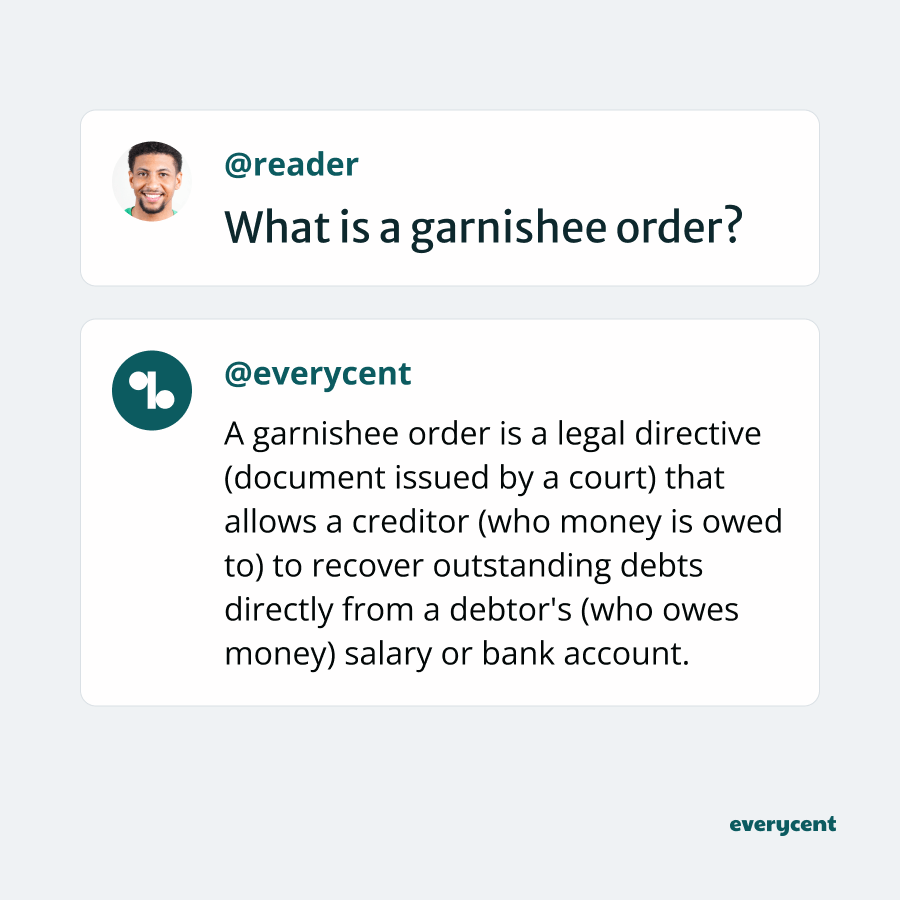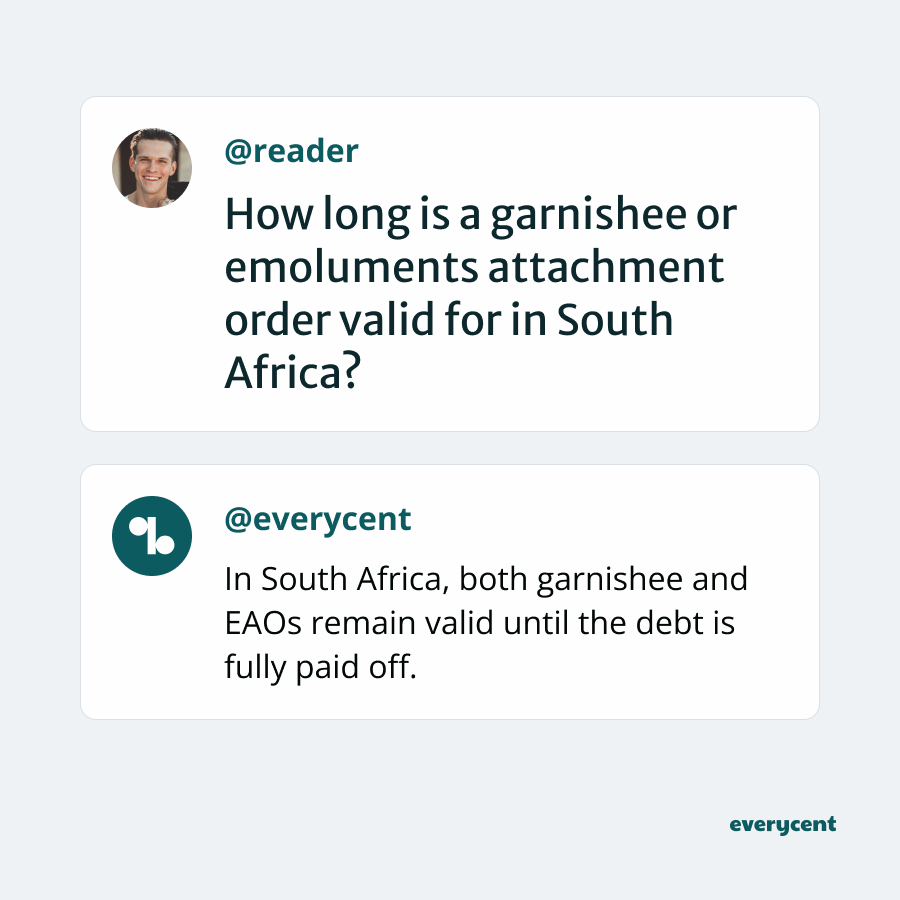
Thanks for checking out this post. We help South Africans manage debt, protect their assets, and restore their finances.
If you’re unfamiliar, then it’s not obvious what a garnishee order is.
And it’s a very important document.
In fact, it’s one of the most reliable ways for creditors to collect outstanding debts.
Sounds like a big deal, right? It is.
We’ll try and simplify it for you.
Here we go.
What is a garnishee order?
A garnishee order is a court-issued legal document that enables a creditor to collect debts directly from a debtor’s bank account or salary. It is an attachment of debt that allows the recovery of owed money by bypassing the debtor’s direct payment.
It means that if someone owes money (known as the debtor) and can’t or won’t pay it back, the court can issue a garnishee order that helps the person [or company] money is owed to (known as the creditor) to get their money back.
📖 Related content: What happens if you can’t pay your debt in South Africa?
This order tells the bank or employer to send part of the debtor’s salary or money in their bank account directly to the person they owe money to. This way, the creditor gets paid back directly without waiting for the debtor to pay.

It’s worth noting that there are two orders that can help creditors to recover debt. Each with a distinct application.
Orders for debt recovery
- Emoluments Attachment Order (EAO), which is used to attach salary or wages; and
- Garnishee Order for debts, which is applied to attach debts owed to the debtor.
An Emoluments Attachment Order (EAO) is specifically for taking money directly from someone’s paycheck when they owe a debt. ‘Emoluments’ means profits, salary, or fees from office or employment.
A Garnishee Order for debts is broader and can collect the outstanding money from different sources. This includes bank account funds, rental income, dividends from investments, or any other payments due to the debtor from third parties (‘garnishee’).

Both orders are governed by the Magistrates’ Court Act of 1944 in South Africa.
Garnishee Orders are covered under Section 72 and Emoluments Attachment Orders (EAOs), under Section 65J.
Furthermore, the National Credit Act 34 of 2005 helps make sure that when these orders are used to collect debts, it’s done fairly and won’t cause undue hardship to the person who owes money.
What are the legal implications, and how much can creditors deduct?
There isn’t a specific amount that a garnishee order [or EAO] may deduct. Instead, The Magistrates’ Court approves or adjusts the amount on a case-by-case basis after taking the debtor’s financial situation and cost of living into account.
For salary deductions, 25% to 30% of the debtor’s net salary is commonly referenced as a guideline.
Another thing to take into account is the accumulation of legal fees.
According to the National Credit Act (NCA) in South Africa, “collection costs” include all legal fees that the creditor incurs during this process. These costs apply for as long as a consumer remains in default under the credit agreement.

Struggling to pay your debt bills?
Check to see if you qualify to lower your debt instalment and free up money for other expenses.
There are two important things consumers should know:
- Debtors have the right to approach the court to lower the deduction amount if it becomes too burdensome or if their financial situation gets worse.
- The Statutory In Duplum rule is in effect in South Africa. This rule limits the accumulation of interest, fees, and charges, including collection costs, to no more than double the unpaid balance of the principal debt at the time of default.
Simply put, consumers have the right to ask the court to reduce how much is deducted if they’re struggling. And, interest, fees, charges, etc. may not build up to more than double the initial debt balance at default.
Now, how long does this last?
How long is a Garnishee Order or Emoluments Attachment Order valid for in South Africa?
In South Africa, both Garnishee Orders and EAOs remain valid until the debt is fully paid off.
That said, it’s important for consumers to regularly review these orders, especially if their financial situation changes or worsens.
Regular reviews can help ensure that everything still complies with legal limits and remains fair.

Getting a garnishee order or EOA should be taken very seriously. It’s generally advisable to seek out professional legal or financial advice.
Let’s go over how the process works.
How do garnishee and emoluments attachment orders work?
Garnishee orders, or EAOs, are part of the debt collection process, and creditors must follow three distinct ‘steps’ to obtain an order.
- The creditor files for an order: The creditor approaches the court with evidence of outstanding debt and files for an order to recover the outstanding debt under the credit agreement.
- The court does an evaluation: To assess the creditor’s claim and the debtor’s financial situation to determine whether to grant or deny the order, and to determine fair terms.
- The court denies or issues an order: Finally, based on the evidence and circumstances, the court either issues an order or denies the creditor’s request.
Now you know how it works. So, how can you prevent, amend, or suspend one an order?
Let’s find out.
How to stop a Garnishee Order
There are several things that a consumer can do to prevent, amend, or suspend a Garnishee Order. What can be done depends on how far along the process is.
Here’s what debtors can do.
Before the court issues a Garnishee Order:
- Apply for debt counselling: A debt counsellor can place the debtor under debt review and offer them legal protection and an affordable repayment plan.
- Negotiate an alternative repayment plan with the creditor: Talk to creditors before things escalate. The creditor might be open to a more manageable arrangement, like a reduced monthly payment or settlement amount. Any agreement should be documented in writing and may require court approval to be effective.
After the Garnishee Order has been issued by the court:
- Seek legal advice to review the Garnishee Order for compliance: Consulting a legal expert is crucial to ensure the Garnishee Order follows all laws and doesn’t take more from your salary than allowed. A lawyer will also verify that the order was properly issued and you were correctly notified.
- Apply to the Court to cancel or modify the order: If the garnishee order doesn’t comply with laws or places an unfair burden on the debtor, they can ask the court to cancel or change it. This requires submitting a request explaining why the order needs adjustment, such as mistakes in the deduction amount, changes in financial circumstances, or issuance without proper notice. The court reviews the request and decides whether to alter, pause, or cancel the garnishee order.
📖 Bonus reading:
- What is an S129 letter of demand?
- Advantages and disadvantages of debt counselling (debt review)
- Consumer rights and debt collection in South Africa
In summary
Our two biggest takeaways:
- Garnishee Orders and Emoluments Attachment Orders are legal directives. Both are very serious.
- The National Credit Act ensures that debtors are treated fairly. Consumers have rights—if you’re a debtor, make sure you’re exercising yours.
To anyone that’s struggling with debt: do your best to address debts proactively and seek advice if you’re unsure how to handle these legal matters (debt counsellors specialise in helping with this kind of thing).
Now you know everything about Garnishee Orders and Emoluments Attachment Orders, plus, how both orders work and how to deal with them.
Want to learn more? Keep reading on Everycent.

Struggling to pay your debt bills?
Check to see if you qualify to lower your debt instalment and free up money for other expenses.
